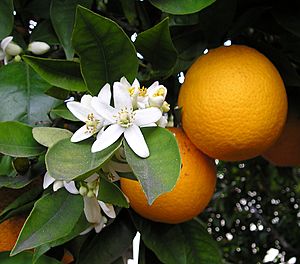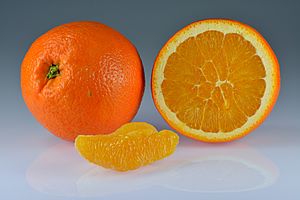Citrus × sinensis facts for kids
Quick facts for kids Citrus × sinensis |
|
|---|---|
 |
|
| Scientific classification | |
| Genus: |
Citrus
|
| Species: |
× sinensis
|
 |
|
The sweet orange (scientific name: Citrus × sinensis) is a very common type of orange. It includes many popular kinds of oranges, like blood oranges and navel oranges. People grow sweet oranges all over the world.
Contents
What Are Sweet Oranges Used For?
The orange fruit is a very important farm product. We use its juicy inside part and its outer skin, called the rind. Even the flowers and leaves of the orange tree have many uses! The wood from the tree is also useful.
Orange Flowers
- The orange blossom is the official flower of Florida. It smells wonderful and is a symbol of good luck. People often use orange blossoms in wedding bouquets and wreaths.
- The strong scent of orange blossoms is used to make perfume. It's a key ingredient in many popular scents.
- You can also make "orange blossom water" from the petals. This water smells like citrus and is used in cooking. It's common in French and Middle Eastern desserts. In some places, people add it to water to make it taste better. In the United States, it's used in things like orange blossom scones.
- In Spain, people dry fallen orange blossoms. They use them to make a special kind of orange tea.
- Orange blossom honey is made when beekeepers place beehives near orange groves. The bees collect nectar from the orange flowers. This helps the trees grow fruit. This honey tastes like oranges and is very popular.
Orange Leaves
- You can boil orange leaves to make orange tea. It has a unique flavor.
Orange Wood
- Orangewood sticks are small tools. They are used for pushing back cuticles during manicures and pedicures. They are also used as spudgers, which are tools for working with small electronic wires.
- Orangewood can be used for grilling meat. It adds a nice smoky flavor, similar to wood from mesquite or oak trees.
Threats to Orange Trees
Giant Swallowtail Caterpillars
Giant swallowtail caterpillars can cause problems for orange trees. These caterpillars eat the leaves, especially on young trees. This can harm the growth of the tree.
See also
 In Spanish: Naranjo para niños
In Spanish: Naranjo para niños

All content from Kiddle encyclopedia articles (including the article images and facts) can be freely used under Attribution-ShareAlike license, unless stated otherwise. Cite this article:
Citrus × sinensis Facts for Kids. Kiddle Encyclopedia.






